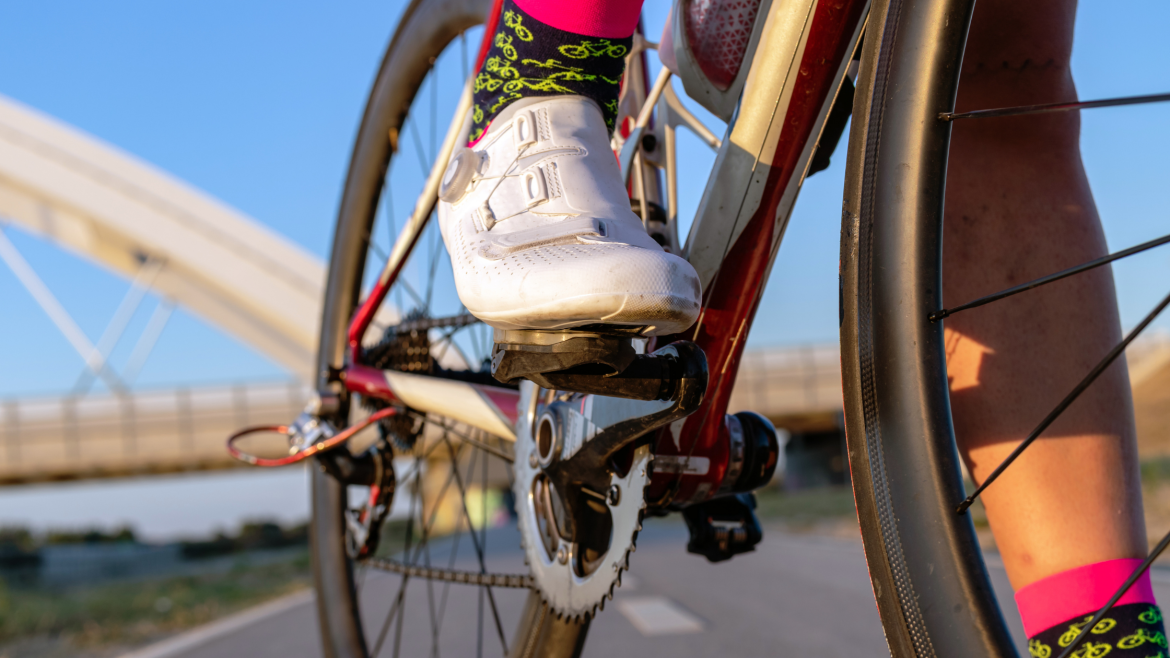 Aug
12
Aug
12
Anti-Slip Technologies in Cycling Shoes
- 12 August 2024
- 0 Comment(s)
Technology has played a huge role in fine-tuning performance and safety in all sporting disciplines, and cycling is no exception. One major area of innovation is anti-slip technologies in cycling shoes.
You must wonder what cycling shoe technology is all about. It refers to various methods and materials that enlarge the grip between the shoe and the ground or pedal. In simpler terms, a good grip on a bike’s pedals is essential for efficient and safe power transfers and the prevention of accidents.
These features are critical, especially on rainy or wet surfaces. These technologies greatly help improve the ride and enhance general safety by avoiding slips and falls. The article will cover the top five anti-slip technologies in cycling shoes that have changed the world of sports.
Why Should You Go for Cycling Shoes Over Road Shoes?
Road shoes seem like an excellent choice for cycling, but performance-wise, dedicated cycling shoes steal the show. They are designed for the rigors associated with cycling and, therefore, do very well in many areas.
First and foremost, cycling shoes transfer force. Their soles are stiff because they are made from carbon fiber and other rigid materials acting together as a platform, ensuring that each watt a person generates is channeled into forward motion. Road shoes, solely designed for walking, have flexible soles that absorb energy rather than transmit it.
Top 5 Anti-Slip Technologies in Cycling Shoes
BOA Fit System
The BOA fit system is a cycling shoe game-changer regarding fit and performance. It’s an innovative technology system replacing traditional laces and straps with a dial and a series of fine wires. This dial allows the user to make excellent adjustments to spread pressure on the foot, thus ridding the user of pressure points and hot spots.
In addition to the comfort, the BOA fit system enhances the performance of the one cycling because it prevents slippage inside the shoe by firmly and evenly locking down the foot for maximum power transmission.
Recessed 2-Bolt Cleat Design
One of the most critical advances in anti-slip technology in cycling shoes is the recessed 2-bolt cleat design. In this design, while the traditional cleat is mounted flush with the sole, the recessed one is mounted lower in the shoe. This design has several advantages. First, it improves walkability. Lowering the cleated shoe drastically increases the contact area between the shoe and the ground, which enhances the stability of walking or hiking off the bike.
On the other hand, an improved feature includes a recessed 2-bolt cleat design that makes pedal engagement much more accessible. In this lowered position, the rider can clip in at a much more natural angle, reducing the possibility of unwanted unclipping. This is very useful when riding vigorously or on technical trails.
Shimano Pedaling Dynamics
SPD is a lot more than anti-slip cycling shoe technology. It is an integral system of pedals and shoes. While best known for its high efficiency in power transfer and the #1 strong connection between the rider and the cycle, SPD excels in providing anti-slip performance.
SPD’s signature recessed cleat design keeps the cleats further away from obstruction on the ground, offering enhanced walkability compared to traditional cleat designs. This is very helpful for mountain bikers who often have to get off their bikes.
On the other hand, SPD has been working toward a stable pedaling platform and secure engagement, which prevents foot slippage while riding and provides better control and confidence, proving to be the best cycling shoe technology.
Shimano Midsole Technology
The Shimano midsole technology is thus a radical step toward the performance-cum-comfort of cycling shoes. It is not an anti-slip feature but indirectly provides overall stability and control.
This acts like a bridge between the outsole and insole, influencing stiffness, shock absorption, and arch support. Shimano’s midsole designs are engineered to optimize power transfer while including enough cushioning.
A stiffened midsole maximizes pedaling efficiency due to less energy loss. At the same time, inclusions of strategically placed flex zones allow natural foot movement, which relieves discomfort from sitting in the saddle for extended hours.
Unidirectional Carbon Fiber
Carbon fiber is very stiff and boasts incredibly high strength relative to weight. When applied to cycling shoe soles, it efficiently transfers the power from the rider through the pedals. This rigidity helps prevent energy loss by flexing the sole.
Carbon fiber increases stability and control during pedaling by preventing the foot from sliding or twisting inside the shoe, lessening flex in the sole. Although carbon fiber’s primary function is to optimize power transfer, it indirectly helps anti-slip performance. A stiffer sole provides a more stable base for the foot, allowing the outsole’s anti-slip features to work effectively.
The Bottom Line About Cycling Shoes Technology
Advances in technology have vastly improved cycling shoes. Innovations like recessed cleats and closure systems, such as the BOA, make a huge difference in grip, comfort, and performance.
The responsible brands, like TD Sportswear, are to incorporate such developments into their products. You want to optimize your riding experience and need the right cycling shoes. Knowing the different anti-slip technologies will help you choose the correct pair for your needs.
Whether you are a seasoned rider or a first-timer, buying a high-quality pair of cycling clothes or shoes with state-of-the-art anti-slip features will go a long way toward ensuring safety and comfort on any ride, whether on the road or the trail.
